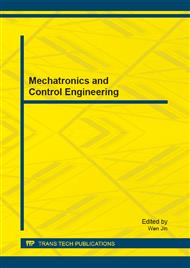p.81
p.87
p.95
p.99
p.104
p.109
p.114
p.118
p.125
Droplets Transportation on a Piezoelectric Substrate with an Obstacle
Abstract:
A method for a droplet transportation by jumping a obstacle on piezoelectric substrate is presented, and a device for the droplet transportation is implemented on a 128° yx-LiNbO3 piezoelectric substrate. An interdigital transducer and a reflector are fabricated on the piezoelectric substrate using microelectric technology. Hydrophobic film is coated on the area free of electrodes and a polydimethylsilicone obstacle is mounted on it. A radio frequency signal amplified by a power amplifier is applied to the interdigital transducer to generate surface acoustic wave. When the surface acoustic wave meets with the droplet on the piezoelectric substrate during transportation, part of acoustic wave enegy is radiated into the droplet, leading to internal acoustic streaming. Once the radio frequency signal with appropriate amplitude is suddenly decreased, part of the droplet will jump the obstacle due to interial force. Red dye solution drops are demonstrated for transportation experiments. Results show that a droplet can be transported from one side to another of the obstacle on piezoelectric substrate by help of surface acoustic wave. The presented method is helpful for microfluidic system on a piezoelectric substrate.
Info:
Periodical:
Pages:
104-108
Citation:
Online since:
July 2013
Authors:
Price:
Сopyright:
© 2013 Trans Tech Publications Ltd. All Rights Reserved
Share:
Citation:


